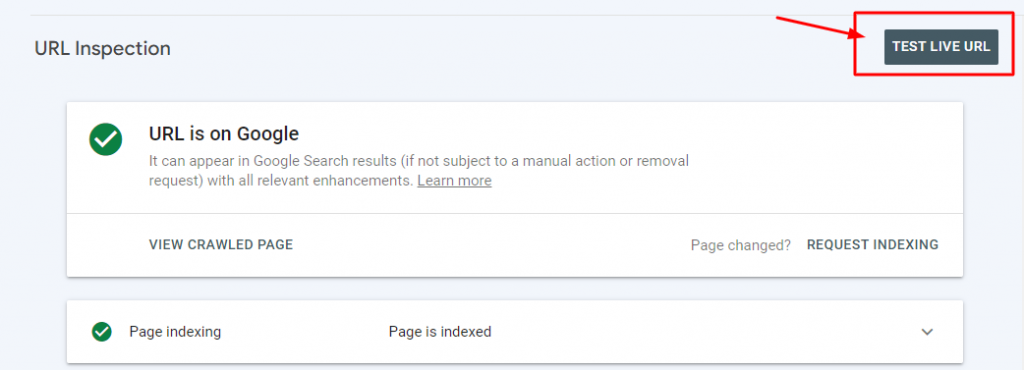In the ever-evolving realm of digital marketing, understanding how search engines index your webpages is crucial. The URL Inspection Tool, provided by Google Search Console, is a powerful tool that empowers website owners to gain insights into the indexing status of their pages. By leveraging this tool effectively, you can enhance your website’s visibility and make informed decisions to improve its search engine performance.
How to Use the URL Inspection Tool?

The process of using the URL Inspection Tool to understand the indexing status can be broken down into several simple steps:
Step 1: Access Google Search Console
To get started, log in to your Google Search Console account. If you don’t have an account yet, you can easily set one up for your website. This tool is invaluable for monitoring your website’s health and performance in Google search results.
Step 2: Enter the URL

Once you’re logged in, navigate to the URL Inspection Tool within the Search Console dashboard. Here, you’ll be prompted to enter the specific URL of the webpage you want to inspect. Enter the URL and click “Inspect.”
Step 3: Review Indexing Status

After clicking “Inspect,” the tool will analyze the URL and provide you with an overview of its indexing status. This status will indicate whether the page is indexed, not indexed, or if there are issues affecting its indexing. If the page is indexed, it means Google has successfully added it to its search index.
Step 4: Diagnose Issues

If the tool indicates that there are issues affecting the indexing status, it will provide details about the problems encountered. These issues could range from server errors to noindex tags on the page. By diagnosing these issues, you can take corrective actions to improve the indexing status.
Step 5: Request Indexing

In cases where you’ve resolved the issues that were affecting indexing, you can use the “Request Indexing” feature. This prompts Google to re-crawl and re-index the page, ensuring that the changes you’ve made are reflected in search results.
Expert Tips for Maximizing the URL Inspection Tool
- Regularly Monitor Indexing Status: Make it a habit to check the indexing status of your critical pages. This proactive approach can help you catch and resolve indexing issues promptly.
- Leverage Coverage Reports: Utilize the Coverage section in Google Search Console to gain insights into the overall indexing status of your website. This report highlights errors, valid pages, and pages excluded from indexing.
- Optimize Page Speed: Slow-loading pages can impact indexing and user experience. Use Google’s PageSpeed Insights tool to identify opportunities for performance improvements.
- Implement XML Sitemaps: XML sitemaps provide search engines with a roadmap of your website’s structure. Ensure your sitemap is up-to-date and submitted to Google Search Console.
Conclusion
In the dynamic landscape of digital marketing, staying ahead of indexing issues is paramount. The URL Inspection Tool equips you with the knowledge you need to ensure your webpages are properly indexed and visible to your target audience. By following the steps outlined above and incorporating expert tips, you can optimize your website’s performance on search engines and drive organic traffic. So, embrace this tool as a vital component of your SEO strategy and unlock the potential for greater online success.
FAQs
Q: Can the URL Inspection Tool improve my website’s ranking?
A: While the tool doesn’t directly influence ranking, it helps ensure your pages are properly indexed. Indexed pages have a better chance of appearing in search results, potentially leading to improved organic traffic.
Q: How often should I use the URL Inspection Tool?
A: Regular monitoring is key. Check critical pages whenever you make significant changes or updates to your website. Additionally, periodic checks for technical issues are advisable.
Q: What should I do if the tool identifies indexing issues?
A: Carefully review the issues identified by the tool and follow the recommended actions. Address any technical problems promptly, and consider seeking assistance from web developers if needed.
Q: Is the URL Inspection Tool the same as crawling and indexing?
A: The tool provides insights into indexing, but it doesn’t replace the crawling and indexing processes. It helps you understand whether your pages are indexed and if there are any issues affecting their visibility in search results.
Q: Can I use the tool for non-Google indexed pages?
A: No, the URL Inspection Tool is specific to Google’s search index. It won’t provide insights into the indexing status on other search engines.
Q: Are there alternatives to the URL Inspection Tool?
A: Yes, other tools like Bing Webmaster Tools offer similar functionalities for Bing’s search index. However, Google Search Console remains the primary tool for Google indexing insights.




